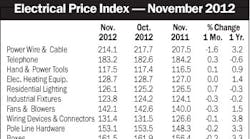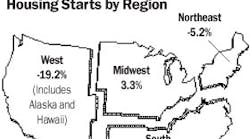Latest from Mag
People - Dec 21, 2012
Obituaries - Dec 21, 2012
November EPI Index Shows No Change
Housing Starts Dip 4% in November
Electrical Marketing - December 21, 2012
Around the Industry - Dec 21, 2012
The Commerce Department reported that sales of new single-family homes rose for the third consecutive month in May to a record-high seasonally adjusted annual rate of 1.16 million units. This was 12.5 percent ahead of April’s seasonally adjusted sales pace, and the fourth time this year that sales have eclipsed the million-unit mark.
“This is one more report that confirms what builders in the field have been saying for the last several months: buyer demand is really being fueled by the outstanding financing climate and solid investment potential of new homes,” said National Association of Home Builders (NAHB) President Kent Conine. Home mortgage rates slipped to 5.3 percent by late May, and median prices of new homes were up 7.8 percent for the month on a year-over-year basis.
“In addition, thin inventories of unsold new homes are an indication of the continuing health and good balance of this marketplace,” said Conine. The Commerce report showed that inventories of unsold new homes in May were down to a 3.5 months’ supply at the current sales rate. “Only once in recorded history has the months’ supply been this low — in November of 1998,” Conine noted.
Sales of new single-family homes in May posted double-digit gains of 16 percent and 19.7 percent in the South and West, respectively, and registered a more modest 1.6 percent gain in the Midwest. A 9.0 percent decline in the Northeast was due to unusually wet weather conditions.
“On the basis of the ongoing strength in sales activity, the favorable outlook for continuing low mortgage rates and rising house values, and the high level of builder confidence registered in our recent housing market index, we are now forecasting that new home sales will hit an all-time record high of 985,000 units in 2003, up about 1 percent from last year’s record-setting 977,000 units,” said NAHB Chief Economist David Seiders. “This performance certainly will maintain housing as a major support to the nation’s economy.”

